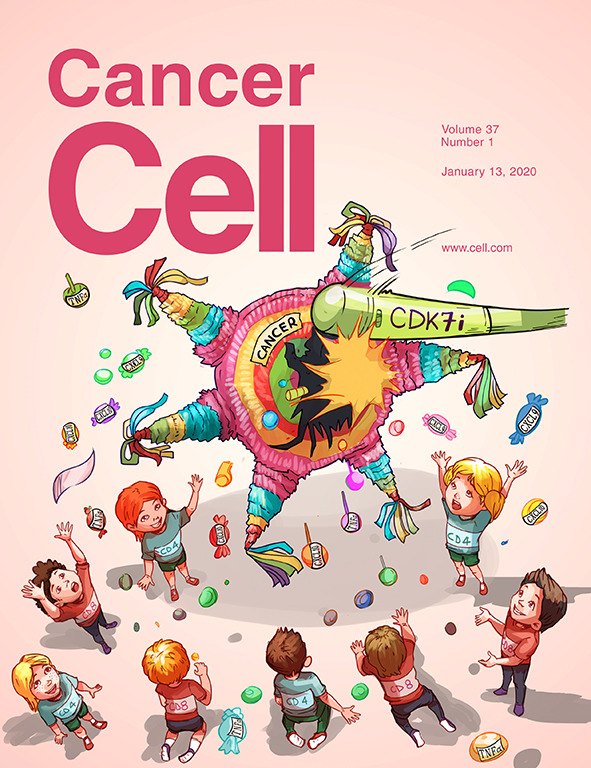elp1相关Sonic hedgehog髓母细胞瘤的遗传模型确定MDM2为选择性治疗靶点
IF 44.5
1区 医学
Q1 CELL BIOLOGY
引用次数: 0
摘要
伸长乙酰转移酶复合体亚基1 (ELP1)的种系功能丧失(LOF)变异是儿童髓母细胞瘤(MB)中最普遍的易感遗传事件,占Sonic hedgehog (SHH) 3亚型的30%。种系ELP1缺陷引发SHH-MB发病机制尚不清楚。在受影响的种系携带者中观察到的模仿杂合Elp1 LOF (Elp1HET)的基因工程小鼠在小脑颗粒神经元祖细胞(GNPs)中表现出恶性前病变的标志性特征,包括DNA复制压力增加、基因组不稳定、细胞周期加速和分化停滞。携带体细胞Ptch1失活的Elp1HET GNPs原位移植产生p53信号受损的shh - mb样肿瘤,为SHH-3亚型中elp1相关的mb的排他性提供了合理的解释。临床前治疗elp1突变患者来源的异种移植物与fda批准的MDM2抑制剂重新激活p53依赖性细胞凋亡和延长生存期。我们的研究结果从功能上证实了ELP1缺乏在SHH-MB易感性中的作用,并推荐了靶向MDM2的治疗方法作为合理的治疗选择。本文章由计算机程序翻译,如有差异,请以英文原文为准。

Genetic modeling of ELP1-associated Sonic hedgehog medulloblastoma identifies MDM2 as a selective therapeutic target
Germline loss-of-function (LOF) variants in Elongator acetyltransferase complex subunit 1 (ELP1) are the most prevalent predisposing genetic events in childhood medulloblastoma (MB), accounting for ∼30% of the Sonic hedgehog (SHH) 3 subtype. The mechanism(s) by which germline ELP1 deficiency provokes SHH-MB pathogenesis remain unknown. Genetically engineered mice mimicking heterozygous Elp1 LOF (Elp1HET) seen in affected germline carriers exhibit hallmark features of premalignancy in cerebellar granule neuron progenitors (GNPs), including increased DNA replication stress, genomic instability, accelerated cell cycle, and stalled differentiation. Orthotopic transplantation of Elp1HET GNPs harboring somatic Ptch1 inactivation yields SHH-MB-like tumors with compromised p53 signaling, providing a plausible explanation for the exclusivity of ELP1-associated MBs in the SHH-3 subtype. Preclinical treatment of ELP1-mutant patient-derived xenografts with an FDA-approved MDM2 inhibitor reactivates p53-dependent apoptosis and extends survival. Our findings functionally substantiate the role of ELP1 deficiency in SHH-MB predisposition and nominate therapeutics targeting MDM2 as a rational treatment option.
求助全文
通过发布文献求助,成功后即可免费获取论文全文。
去求助
来源期刊

Cancer Cell
医学-肿瘤学
CiteScore
55.20
自引率
1.20%
发文量
179
审稿时长
4-8 weeks
期刊介绍:
Cancer Cell is a journal that focuses on promoting major advances in cancer research and oncology. The primary criteria for considering manuscripts are as follows:
Major advances: Manuscripts should provide significant advancements in answering important questions related to naturally occurring cancers.
Translational research: The journal welcomes translational research, which involves the application of basic scientific findings to human health and clinical practice.
Clinical investigations: Cancer Cell is interested in publishing clinical investigations that contribute to establishing new paradigms in the treatment, diagnosis, or prevention of cancers.
Insights into cancer biology: The journal values clinical investigations that provide important insights into cancer biology beyond what has been revealed by preclinical studies.
Mechanism-based proof-of-principle studies: Cancer Cell encourages the publication of mechanism-based proof-of-principle clinical studies, which demonstrate the feasibility of a specific therapeutic approach or diagnostic test.
 求助内容:
求助内容: 应助结果提醒方式:
应助结果提醒方式:


